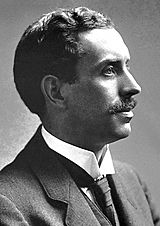Charles Glover Barkla facts for kids
Quick facts for kids
Charles Barkla
|
|
|---|---|

Barkla in 1917
|
|
| Born |
Charles Glover Barkla
7 June 1877 Widnes, Lancashire, England
|
| Died | 23 October 1944 (aged 67) |
| Nationality | British |
| Alma mater | University College Liverpool Trinity College, Cambridge King's College, Cambridge |
| Known for | X-ray scattering X-ray spectroscopy Characteristic X-ray |
| Awards | Nobel Prize in Physics (1917) Hughes Medal (1917) Fellow of the Royal Society (1912) |
| Scientific career | |
| Fields | Physics |
| Institutions | University of Cambridge University of Liverpool King's College London University of Edinburgh |
| Academic advisors | J. J. Thomson Oliver Lodge |
Charles Glover Barkla was a smart British physicist. He won the famous Nobel Prize in Physics in 1917. He received this award for his important work with X-rays. He studied how X-rays move and interact with different materials. His discoveries helped us understand more about the tiny parts that make up everything.
Contents
Charles Barkla's Life Story
Early Life and Education
Charles Barkla was born on June 7, 1877, in Widnes, England. His father, John Martin Barkla, worked for a chemical company. His mother, Sarah Glover, was the daughter of a watchmaker.
Charles went to the Liverpool Institute for Boys. After that, he studied at Liverpool University. He first studied math but then focused on Physics. His teacher was Sir Oliver Lodge. Charles even taught some classes when Sir Oliver Lodge was sick.
In 1899, Charles went to Trinity College, Cambridge. He worked in the Cavendish Laboratory with J. J. Thomson. Thomson was a very famous physicist who discovered the electron. For two years, Charles studied how electromagnetic waves travel along wires.
Music and Family
After some time at Trinity College, Charles moved to King's College, Cambridge. He loved music and wanted to sing in the chapel choir. He had a beautiful singing voice. People always came to hear him sing solo.
He finished his first university degree in 1903. He earned a higher degree in 1907. In the same year, he married Mary Esther Cowell. They had two sons and one daughter together.
Becoming a Professor
Charles Barkla worked at several universities. These included Cambridge, Liverpool, and King's College London. In 1913, he became a Professor of Natural Philosophy at the University of Edinburgh. He stayed in this important job until he passed away.
Discoveries About X-rays
Understanding X-ray Behavior
Charles Barkla made big steps in understanding X-ray scattering. This is how X-rays bounce off things. He also studied X-ray spectroscopy. This helps us learn what materials are made of by looking at their X-ray patterns.
He figured out how X-rays pass through different materials. Most importantly, he learned how secondary X-rays are created. These are new X-rays that appear when primary X-rays hit something.
Winning the Nobel Prize
Charles Barkla discovered something called "characteristic X-rays" of elements. This means that each element gives off its own special X-ray pattern. This discovery was very important for science.
Because of this amazing work, he won the Nobel Prize in Physics in 1917. He also received the Hughes Medal from the British Royal Society in the same year.
A Theory That Didn't Stick
Barkla also suggested a new idea called the "J-phenomenon." He thought it was a new way X-rays behaved. However, other scientists were not convinced. They believed it was similar to other known effects, like Compton scattering. So, his J-phenomenon theory was not widely accepted.
Public Recognition
Many things have been named after Charles Barkla to honor his work.
- The lunar crater Barkla on the Moon is named after him.
- There is a plaque on his house in Edinburgh, Scotland.
- Another plaque is at the University of Edinburgh.
- A lecture hall and a lab at the University of Liverpool are named after him.
- In his hometown of Widnes, a road gritter (a truck that spreads salt on roads) was named in his honor in 2012.
- A retirement housing complex in Widnes is called Barkla Fields.
Images for kids
See also
 In Spanish: Charles Glover Barkla para niños
In Spanish: Charles Glover Barkla para niños



